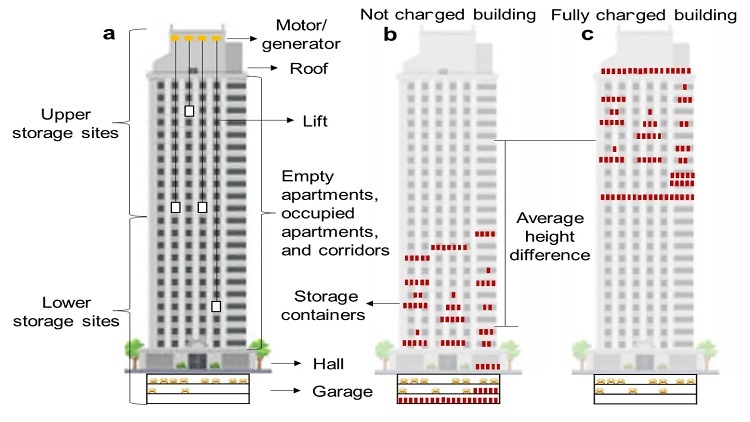S. Himmelstein | June 22, 2022
 (a) LEST system components, (b) not changed and (c) fully charged building. Source: Hunt et al./Energy (2022) 10.1016/j.energy.2022.124102
(a) LEST system components, (b) not changed and (c) fully charged building. Source: Hunt et al./Energy (2022) 10.1016/j.energy.2022.124102
Projections of the near-term rapid penetration of renewable energy systems in urban settings point to the need for new approaches to energy storage. An international research team has proposed a gravitational-based storage solution that makes use of elevators and empty apartments in tall buildings for such storage application.
Lift Energy Storage Technology (LEST) creates additional value for the power grid and property owners by harnessing the use of elevators, or lifts, already installed in high-rise buildings. LEST can be combined with batteries or other storage options to balance the short-term variations of electricity demand and solar and wind generation.
These systems are envisioned to store energy by lifting wet sand containers or other high-density materials, which are transported remotely in and out of an elevator with autonomous trailer devices. Elevators equipped with regenerative braking systems can harvest energy as they descend, effectively functioning as pre-installed power generators.
Energy is stored as potential energy in the charging mode by elevating storage containers with an existing lift in the building from the lower storage site to the upper storage site. Electricity generated by lowering the storage containers from the upper to the lower storage site in the discharge mode can be consumed on-site or transmitted to the grid.
The research reported in the journal Energy estimates the installed storage capacity cost to be in the $21/kWh to $128/kWh range, depending on building height. The higher the height difference between the lower and upper storage sites, the lower project cost for LEST.
Researchers from Federal University of Espírito Santo (Brazil), International Institute for Applied Systems (Austria), Wrocław University of Science and Technology (Poland), Wrocław University of Environmental and Life Sciences (Poland), Federal University of Alfenas (Brazil), Federal University of Rio de Janeiro (Brazil) and Hamburg University of Applied Sciences (Germany) contributed to this study.
